|
F4F-3 Wildcat

Eduard ProfiPACK, 1/48 scale
S
u m m a r y |
| Catalogue Number: |
Eduard Kit No. 82201 - F4F-3 Wildcat ProfiPACK |
| Scale: |
1/48 |
| Contents and Media: |
131 parts in grey coloured plastic (including 31 marked not for use); 26 parts in clear (12 marked not for use); colour photo-etched fret with 61 parts; self-adhesive masking sheet; markings for six aircraft |
| Price: |
USD$54.95 plus shipping,
available online now from Eduard
GBP£29.20 (£24.43 Export Price) plus shipping available from Hannants |
| Review Type: |
FirstLook |
| Advantages: |
Very high level of detail; world beating surface features including crisply recessed panel lines, raised and recessed rivets, fabric texture, rib tapes and stitching; includes colour photo-etched parts; separate control surfaces; many options, some applicable to future releases. |
| Disadvantages: |
No open cowl flap option. |
| Conclusion: |
The first all-new release in Eduard's Wildcat family, this 1/48 scale F4F-3 is simply a beautiful model. Eduard has not rested on its laurels - I think the subtle fabric and recessed textures on display here are their best yet. The cockpit is a gem right out of the box, but the inclusion of colour photo-etch in this debut ProfiPACK edition will lift it to even greater heights. From day one Eduard has also released a slew of multi-media update sets for the cockpit, undercarriage, wheels, guns and more, so you can decide for yourself whether to go straight from the box or super detailed. Another winner from Eduard - I can't wait to start mine! |
Reviewed by Brett Green

The Grumman F4F Wildcat is an American carrier-based fighter aircraft that began service in 1940 with the United States Navy, and the British Royal Navy where it was known as the Martlet.
First used by the British in the North Atlantic, the Wildcat was the only effective fighter available to the United States Navy and Marine Corps in the Pacific Theatre during the early part of the Second World War. The disappointing Brewster Buffalo was withdrawn in favour of the Wildcat and replaced as aircraft became available.
With a top speed of 318 mph, the Wildcat was outperformed by the faster 331 mph, more manoeuvrable, and longer-ranged Mitsubishi A6M Zero. However, the F4F’s ruggedness, coupled with tactics such as the Thach Weave and hit-and-run manoeuvres using altitude advantage resulted in a claimed air combat kill-to-loss ratio of 5.9:1 in 1942 and 6.9:1 for the entire war.

Lessons learned from the Wildcat were later applied to the faster F6F Hellcat. While the Wildcat had better range and manoeuvrability at low speed, the Hellcat could rely on superior power and high speed performance to outperform the Zero.
In addition to production by Grumman, General Motors / Eastern Aircraft produced 5,280 FM variants of the Wildcat.
Grumman’s Wildcat production ceased in early 1943 to make way for the newer F6F Hellcat, but General Motors continued to produce Wildcats for both U.S. Navy and Fleet Air Arm use.
Even when the Wildcat was obsolescent as a front line fighter compared to the F6F Hellcat or the much faster F4U Corsair, it remained adequate for small escort carriers against submarine and shore threats. These relatively modest ships only carried two types of aircraft, the Wildcat and GM-built TBM Avenger. The Wildcat's lower landing speed and ability to take off without a catapult made it more suitable for shorter flight decks.*
*Historical summary adapted from Wikipedia
F4F-3 Wildcat
The F4F-3 was the first variant to see combat, in the guise of the Martlet Mk.I in Royal Navy service.
Compared to later variants, the F4F-3 had four wing-mounted .50 cal machine guns, a different cowl and radiator flap arrangement, and non-folding wings.
The F4F-4 entered service in 1941 but its performance was noticeably inferior to its lightweight predecessor and it was initially unpopular with pilots.
It is always exciting to lift the lid of the first kit in a brand new family from Eduard.
Eduard's debut 1/48 scale release depicts the first Wildcat to see combat - the F4F-3.
This all new 1/48 F4F-3 Wildcat ProfiPACK edition comprises 131 parts in grey coloured plastic (including 31 marked not for use), 26 parts in clear (12 marked not for use), a colour photo-etched fret with 61 parts; a self-adhesive masking sheet and markings for six aircraft.
Subtract optional parts from these numbers and we are looking at a surprsingly modest total of plastic parts.
However, this does not imply any compromise in detail.
Indeed, detail is excellent. The cockpit is built up from plastic and photo-etched parts. With its tubby fuselage, there is plenty of space to build the cockpit up from the bulkheads to the accurate see-through floor, pilot's foot rails, busy side consoles, rudder pedals and the instrument panel.
Colour photo-etched parts are supplied for the instrument panel, but alternative dial decals are offered as an option if you prefer.
The crisply pre-painted panels for the side consoles are another highlight, as are the impressively shaded harness straps. Alternative straps are supplied for pre-war and early (lap belts only) or later wartime (shoulder and lap straps) variants.
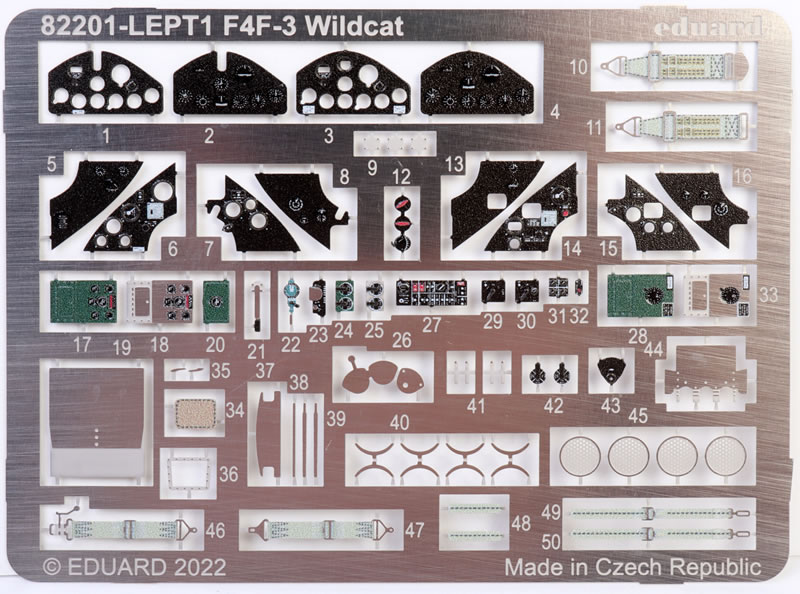
The firewall doubles as a rigid base for the wing spars.
The engine mounts are made up from three cleverly designed pieces that plug directly into the back of the engine.With careful handling this should be an impressive looking structure.
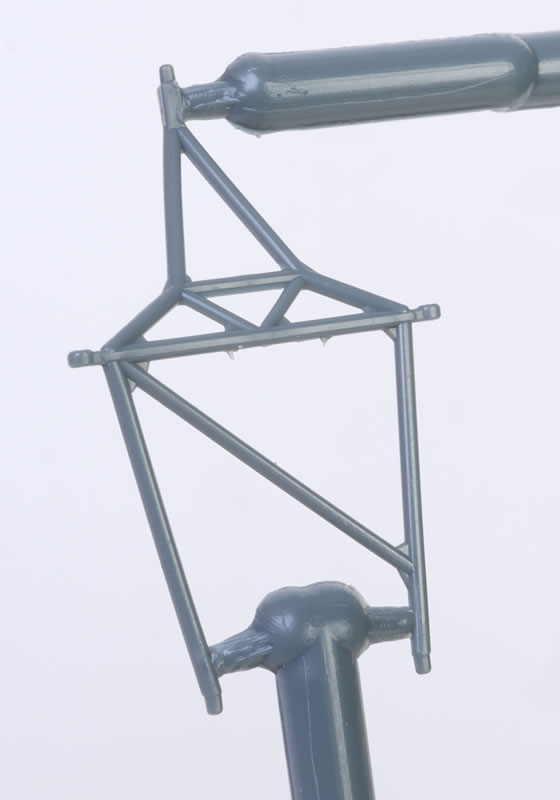
The instructions recommend that you trim a little from the inside of the lower fuselage window opening before gluing the clear pieces in place. Ignore the instructions at your peril!
The textures on this model are superb - perhaps their best yet.
I really like the stretched fabric effect on the control surfaces, along with rib tapes and stitching detail.
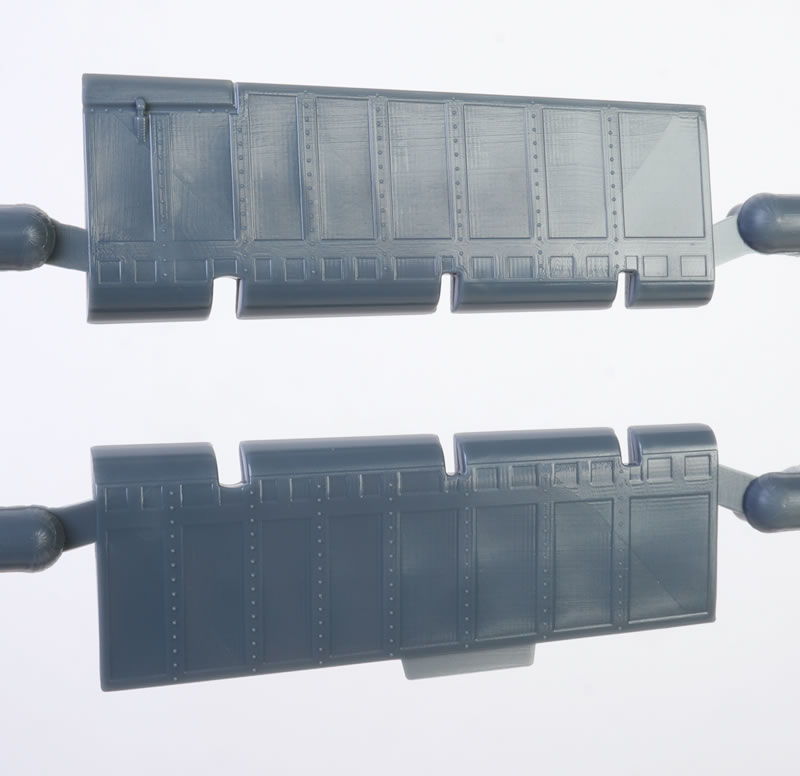
The combination of recessed and raised rivets on the fuselage is a nice touch too. It is very subtle - more of a touchable texture than an obvious feature. The lines of recessed rivets are particularly fine.

Parts breakdown is conventional. The upper and lower wings are split into port and starboard halves. They will slide onto the stout wing spars later in the assembly sequence. All control surfaces are separate.
There was discussion some weeks ago about raised gun access panels on the upper wings.
Having the model in front of me right now, the raised panels are very restrained. They are even hard to see under the unforgiving glare of my big Bowens strobes, carefully angled to pick up the effect. It is so subtle that you really have to look for it.
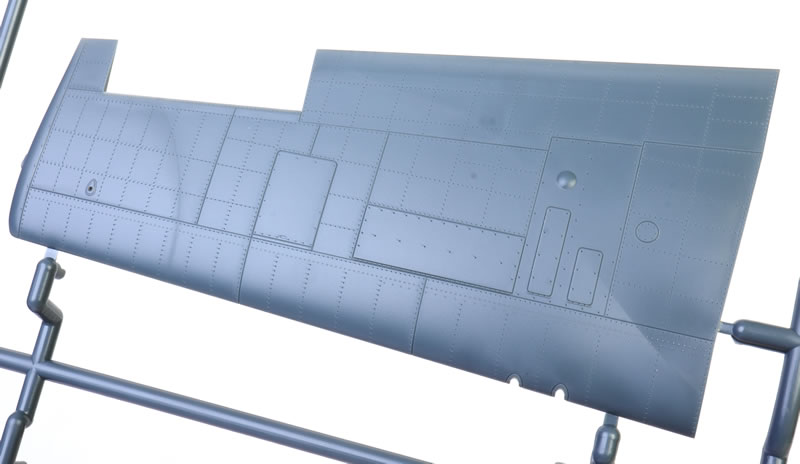
The characteristically spindly undercarriage is built up from a number of fine plastic parts. Their assembly is cleary illustrated in the instructions.
Main wheels are moulded with radial tread and a separate covered hub. The tyres are not bulged or flattened.
Two styles of tail wheel are supplied - one with a pneumatic tyre and another with a smaller solid rubber type.
The engine is simply broken down into four parts - two rows of cylinders, a ring of push rods and crankcase cover. Ignition harness is not included.
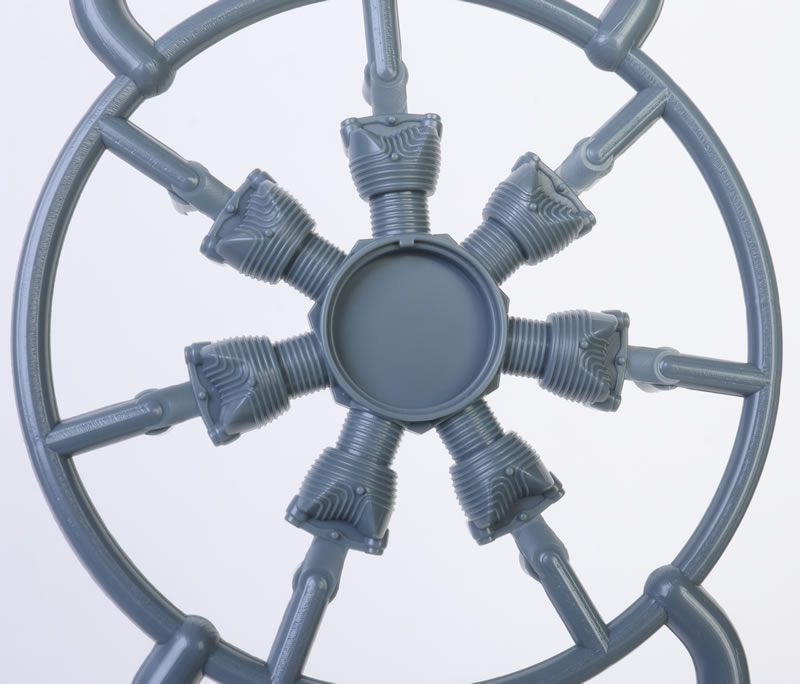
You are also offered the choice of three different forward cowls and two side cowlings. Cowl flaps are closed on all options. The instructions advise which parts are applicable to what marking option.
Wing mounted bomb racks are optional. The wing machine guns are not hollowed out at the end but the cooling jackets feature deep holes that look great.
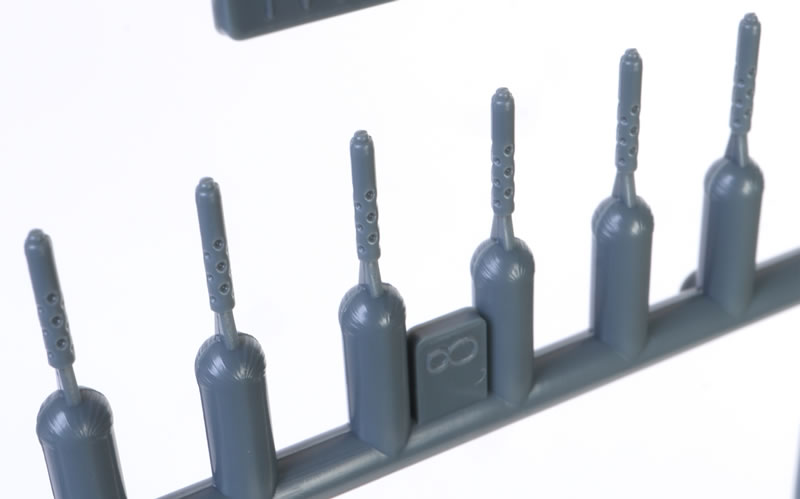
Three antennae on the lower fuselage are supplied as flat photo-etched parts. I'll be replacing these with fine metal rod. Check your references for the correct location of these.
The clear sprue is free from distortion. There are a number of options here, including different parts for open and closed canopies.
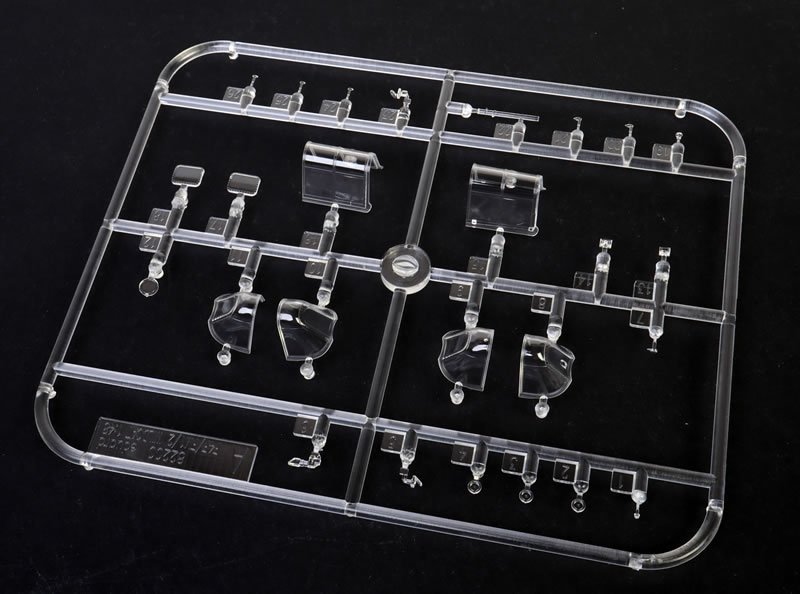
A windscreen with a hole to accommodate a telescopic sight is also provided.
Instructions are supplied in a 16 page stapled A4 booklet. As you'd expect, the diagrams are logical and easy to follow.
Markings
Markings are supplied for six schemes with some interesting and varied markings from pre-war to Pacific warrior.
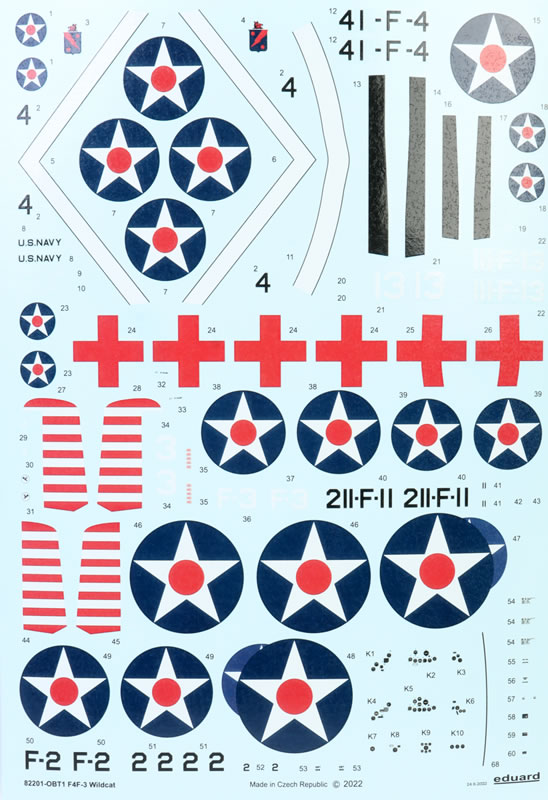
The decal sheets are perfectly printed by Eduard.
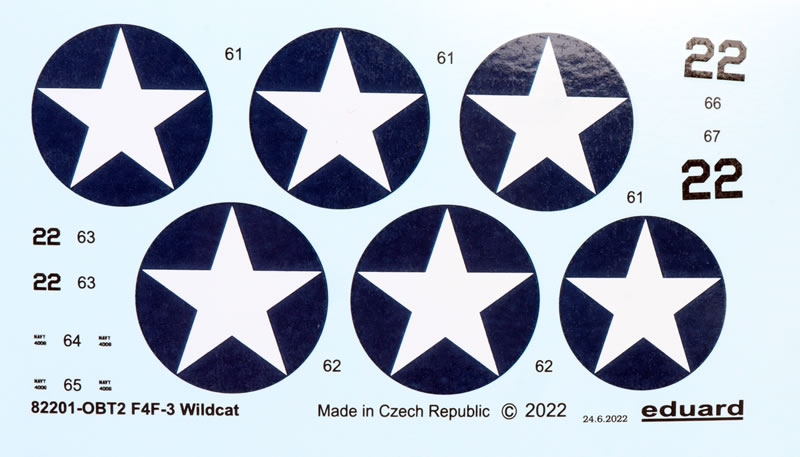
A small errata sheet is also included.
Six colour four view diagrams and historical notes are included for all of the schemes.
Eduard After Market Accessories
To coincide with the kit's launch, Eduard has also released ten after-market upgrade sets in resin, 3D printing, photo-etch and more:
-
EX878 - Canopy Masks
-
481086 - Landing Flaps
-
644172 - LOOK Colour Instrument Panel incl. Harness and 3D Printed Parts
-
648766 - PRINT 3D Printed Exhausts
-
648767 - PRINT 3D Printed Wheels (Early)
-
648769 - PRINT 3D Printed Gun Barrels (x6)
-
648777 - PRINT 3D Printed Cockpit
-
648779 - BRONZE Undercarriage Legs
-
3DL48076 - SPACE Late Version Cockpit Detail Set (3D printed and photo-etched)
-
FE1290 - STEEL Seat Belts
These will be reviewed individually on HyperScale over the next week or so.
I am sure that we'll be seeing more accessory releases in the near future too!
The first all-new release in Eduard's Wildcat family, this 1/48 scale F4F-3 is simply a beautiful model.
Eduard has not rested on its laurels - I think the subtle fabric and recessed textures on display here are their best yet.
The cockpit is a gem right out of the box, but the inclusion of colour photo-etch in this debut ProfiPACK edition will lift it to even greater heights.
From day one Eduard has also released a slew of multi-media update sets for the cockpit, undercarriage, wheels, guns and more, so you can decide for yourself whether to go straight from the box or super detailed.
This is another winner from Eduard - I can't wait to start mine!
Thanks to Eduard for the sample
Review Text Copyright © 2022 by
Brett Green
Page Created 9 August, 2022
Last updated
10 August, 2022
Back to HyperScale Main Page
Back to Reviews Page |
